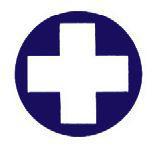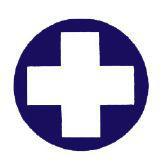SAS Urban Survival Handbook (117 page)
Read SAS Urban Survival Handbook Online
Authors: John Wiseman
Tags: #Health & Fitness, #Reference, #Survival, #Fiction, #Safety, #Self-Help, #Personal & Practical Guides, #General, #Survival Skills

Immunization
It is possible to induce or boost immunity to certain serious diseases. All that is usually required is one or more injections of appropriate vaccines. Immunization against polio is even simpler—the vaccine may be swallowed on a lump of sugar. Immunization has brought many diseases under control. Smallpox has actually been eradicated!
Routine immunization is given to babies and young children at various ages. Your doctor or clinic will advise on this (see
Childhood diseases
).
Seek advice when you intend to travel abroad. A doctor/ travel adviser will be able to tell you which serious diseases you need to be immunized against in any particular region (see
Tropical diseases
and IN TRANSIT).
The following vaccines are routinely available:
- ◑
MMR:
Mumps, measles and German measles (rubella) - ◑
DPT:
Diphtheria, whooping cough (pertussis) and tetanus - ◑
Polio - ◑
Influenza
Only for two out of three strains - ◑
Hepatitis B - ◑
Meningitis
Only for two out of three strains - ◑
Cholera - ◑
Typhoid - ◑
Rabies
REMEMBER
Immunization for influenza is normally only given to the elderly or those at occupational risk. Cholera and typhoid vaccines offer only partial protection. Other precautions, such as food and water hygiene, should be observed in areas where there is a risk of contracting the diseases.

WARNING
Vaccines may be dangerous if you are pregnant, if you are HIV positive, if you have cancer or any prolonged fever or infection. Always state whether you are taking any medication.
YOU AND YOUR DOCTOR
 Many doctors would much prefer to be educators, helping you to adopt a healthier lifestyle, suggesting positive ways of self-help,
Many doctors would much prefer to be educators, helping you to adopt a healthier lifestyle, suggesting positive ways of self-help,
encouraging and monitoring rather than treating. Whether or not such an ideal is attainable, use your doctor’s knowledge, help and advice to prevent ill health in the first place. The traditional idea that a visit to a doctor is only necessary if you are actually ill is gradually changing.
Preventative medicine must involve a two-way discussion between you and your doctor on ways you can spot trouble before it becomes serious. More important, you need advice on how to make sure that problems are less likely to occur.
However, most people still only see a doctor when they experience illness, pain or discomfort—to seek reassurance, advice or treatment—or worse still, when their condition is so serious that emergency action (such as instant hospital admission) is required.
REMEMBER
When you visit your doctor, it is VITAL that he/she understands what is troubling you. Although doctors are trained to communicate with their patients, you might find your doctor difficult to talk to or understand. Don’t feel inhibited about discussing personal matters—he/she is professionally bound to keep your conversation confidential. You should be free to talk about anything that is bothering you. It is possible that you and your doctor might not ‘get on’. Find another doctor.
Get organized
The responsibility for describing and pointing out symptoms lies with YOU—your doctor cannot read your mind. There are some important ways in which you can prepare for a visit to the doctor, to make the best use of the time:
- ◑ Check in your own mind why you want an appointment.
- ◑ Think over how you have been feeling. Have there been any significant changes in your eating habits, your bowel habits or sleeping patterns?
- ◑ Think about any particular worries that you may have.
- ◑ Make notes—your mind might go blank during a consultation or you might forget something important.
- ◑ Always be totally honest.
How doctors work
A consultation with your doctor usually involves several processes. The first is history-taking—the doctor asks a series of carefully selected questions, which are designed to build up a picture of your problems. While you are talking, a good doctor will not only be listening but also seeing whether your appearance gives clues to your state of health. He/she is checking to see if you look relaxed and generally fit and healthy. Your skin, hair, eyes and teeth all can give indications of your general condition.
If your doctor thinks it necessary he/she may move on to the next process—a physical examination.
Diagnosis
It is not always possible for a doctor to make an immediate diagnosis and it would not be proper for him/her to guess at your condition. If the doctor has taken a blood or urine sample, for example, there may be a delay until the results of tests have been returned.
If the doctor is able to diagnose your condition at once, it is VITAL that you understand the explanation the doctor gives you, and the prescription and the treatment he/she recommends. Write down any instructions and ask for an explanation of any part of the diagnosis that is too ‘technical’.
Finally, FOLLOW THE DOCTOR’S ORDERS—but if the suggested treatment does not appear to be effective, make another appointment.

WARNING
If you suspect serious illness or you are in considerable pain seek medical assistance—go to your doctor, call your doctor or (if necessary) call an ambulance. Of course it may be a false alarm, but a good doctor prefers a patient who is worried about a symptom to raise the alarm, rather than suffer in silence.
You may hold back because you don’t want to ‘bother’ a doctor, but you are not qualified to decide whether a problem is serious or not. If there is any risk at all that the condition could be serious, speedy diagnosis and treatment are VITAL.
If you need a doctor to visit you at home, telephone early in the day, so that the doctor can plan the day’s visits’.
If you, or a child, may be suffering from an infectious disease, don’t carry the infection to the doctor’s waiting room—ask for a home visit.
If a child’s temperature is raised beyond 39° C (102° F), it is definitely advisable to ask a doctor to visit.

WARNING
X-rays are invaluable and—compared with recent inventions—employ quite basic technology, but they must be used with care. The x-ray ‘image’ is achieved by passing a form of electromagnetic radiation through the body. An image is created on a photographic plate behind the body.
The use of this radiation has recently caused great concern.
At high levels, it can cause neurological disorders and cancers.
The dosage of radiation necessary to take an x-ray photograph is usually small, but doctors are worried that too many unnecessary x-rays are given. The effect is cumulative. One report revealed that in the UK at least a fifth of all x-ray examinations did not actually provide new or useful information. ALWAYS check with the doctor that an x-ray is essential. Keep a personal record of your own x-rays—when they were taken and why.
With heavy workloads in many hospitals, radiologists and occasionally their patients have been exposed to unnecessarily high levels of radiation from x-rays, as a result of ineffective protective and screening procedures. In some countries x-ray procedures may have to be closely examined.
Seeing a specialist
Depending on your particular problem, your doctor may not be able to make a diagnosis from history-taking and a physical examination. You may be referred to a specialist or consultant, perhaps at a hospital. Consultants and specialists usually focus their training on particular types of problem and have access to a wide range of high-tech procedures. ‘Imaging’ techniques allow doctors literally to ‘see’ into their patients.
Ultrasound, computed tomography (CT) scanning, magnetic resonance imaging (MRI) and positron emission tomography (PET) scanning sound like science fiction. These techniques use various forms of electro-magnetic rays, sound waves and radioactive substances to create ‘images’. There’s usually little or no discomfort.
Endoscopy, the use of special viewing instruments that can be inserted into the body, has greatly improved since the advent of fibreoptic technology. If absolutely necessary, minute samples of possibly diseased tissues can be painlessly removed for examination (biopsy) at the same time. Quite often, if there is an incision at all, it’s tiny.
Ultrasound
Ultrasound is a diagnostic method in which high-frequency sound waves are transmitted into the body. Their reflections show images of body organs, observable on a screen. It is thus possible to detect abnormalities and pinpoint their position. It is claimed that the technique is completely safe. There is growing concern that the use of ultrasound during pregnancy should be limited to one ‘screening’, unless an abnormality is found. No one yet knows whether long-term damage to the baby might be caused by too many routine screenings.
TREATMENT
 Even the relatively short space of ten years has transformed some areas of modern medicine. While the basic practices of the doctor’s surgery
Even the relatively short space of ten years has transformed some areas of modern medicine. While the basic practices of the doctor’s surgery
remain unchanged, the treatment of illness has seen major advances. Like other areas of modern life, computer technology has speeded up developments, allowing medical science to discover and understand more about the human body.
